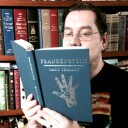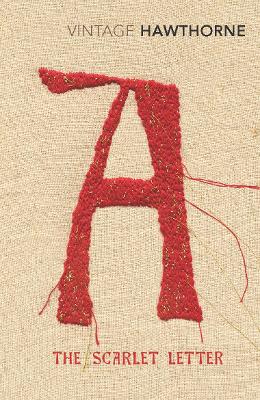
'One of the greatest allegories in all literature' D.H. Lawrence
Hester Prynne is a beautiful young woman. She is also an outcast. In the eyes of her neighbours she has committed an unforgivable sin. Everyone knows that her little daughter, Pearl, is the product of an illicit affair but no one knows the identity of Pearl's father. Hester's refusal to name him brings more condemnation upon her. But she stands strong in the face of public scorn, even when she is forced to wear the sign of her shame sewn onto her clothes: the scarlet letter 'A' for 'Adulteress'
- ISBN10 0099511266
- ISBN13 9780099511267
- Publish Date 1 May 2008 (first published 1 January 1850)
- Publish Status Active
- Publish Country GB
- Publisher Vintage Publishing
- Imprint Vintage Classics
- Format Paperback (B-Format (198x129 mm))
- Pages 288
- Language English
Reviews

Written on Oct 17, 2015

cherryblossommj
Written on May 14, 2013
--
Own the Dover Thrift Edition from high school. Also have a MMP Signet Classics, but cannot find that edition or the cover image anywhere online.

bumblingbookworm
Written on Oct 29, 2012

Rinn
Written on Jun 19, 2012

Linda
Written on Feb 14, 2011
It is kind of scary that some people who left Europe for America did so in order to avoid prosecution for their religious beliefs, however, some of those puritans must have been a lot worse than those religious zealots cleaing up in Europe? And throughout the whole book, I had one phrase stuck in my mind : the one who has never sinned should cast the first stone.

Briana @ Pages Unbound
Written on Jan 1, 2011
Subtlety with symbolism is not one of the author’s talents; he is about as understated as the gold and red embroidery on the letter A that Hester must wear upon her chest as punishment for her crime. The reader barely makes it to the second page before finding a description of a rose bush that is followed by the instruction: “It [a rose] may serve, let us hope, to symbolize some sweet moral blossom, that may be found along the track, or relieve the darkening close of a tale of human fragility and sorrow.” Once the scarlet A makes its appearance, it is denoted immediately as a “token of shame.” In case this is not explicit enough, the letter will later flash through the night sky in the wake of a meteor and the narrator explains that Hester’s paramour sees it as a symbol of his guilt. Hawthorne is not entirely misguided in his employment of symbolism; the Puritans did have an affinity for signs themselves and their presence in the book lends something of historical accuracy. However, their overuse is somewhat problematic—and not solely because the readers must begin to question whether. Hawthorne believes them to be as obtuse as he renders his fellow custom-house workers in his autobiographical introduction. Because Hawthorne is so direct presenting some of the meaning of his work, readers might miss the places where he leaves them room for interpretation.
One such instance is his representation of the role of women. Hester’s marriage was oppressive to her youth and beauty, a portrayal that contradicts the expected place of women in both Puritan society and Hawthorne’s own. No happily married woman in the book marks Hester as an exception. Later Hester asks herself:
“Was existence worth accepting, even to the happiest [women] among them? … As a first task, the whole of society is to be torn down, and built up anew. Then the very nature of the opposite sex, or its long hereditary habit, which has become like nature, is to be essentially modified before woman can be allowed to assume what seems a fair and suitable position. Finally, all other difficulties being obviated, woman cannot take advantage of these preliminary reforms, until she herself shall have undergone a still mightier change; in which, perhaps, the ethereal essence, wherein she has her truest life, will be found to have evaporated.”
Her thoughts begin as radical, suggesting some of today’s theories about gender as a social construct, but they end pessimistically and with doubt that change for women is possible. Hawthorne never answers completely the question of what a women’s role or nature is and what should be done about it, leaving it for his readers to muse.
Hawthorne’s second major question is whether society should judge an individual or whether that is God’s job alone. Modern readers, if they are not personally religious, may not see this as a legitimate debate, but its importance to the Puritan theocracy is obvious, and Hawthorne clearly wants his own Christian readers to ask themselves this question. Hawthorne depicts the Puritans as hypocritical, and Hester wonders whether “the outward guise of purity [of her neighbors] was but a lie, and that, if truth were everywhere to be shown, a scarlet letter would blaze forth on a many a bosom.” Her thoughts lead readers to ask themselves whether they too have failed and if they are eager to criticize others in order to draw attention away from their failings. The conclusion of The Scarlet Letter indicates Hawthorne’s own opinions about personal confession and societal judgment, but, again, he does not give a complete answer.
The Scarlet Letter is in many ways very direct, featuring open criticism and obvious symbolism. Hawthorne did not intend to write a didactic work, however. He is interested in raising what he considers essential questions, but he only hints at his own answers, leaving interpretation primarily in the hand of the readers. The combination of strong authorial voice and subtlety make this one classic worth reading.
This review was also posted at Pages Unbound Book Reviews

Michael @ Knowledge Lost
Written on Jul 3, 2010
Hester Prynne, the bearer of the Scarlet “A” on her breast, her badge of shame. Branded for adultery for everyone to see, Hester still has a desire to redeem herself. She never reveals her lover’s identity and for that she has been publically shamed.
Her lover is a well respected member of the community (I won’t reveal who it is just in case people aren’t aware and don’t want a spoiler). He is faced with carrying the burden of his sin in secret, always putting his hand over his heart, an expression of the pain that is dwelling up inside him. He lives with his sin until it all begins to unravel and he breaks.
Roger Chillingworth is Hester’s husband; ashamed of the betrayal, he had changed his name so no one would know. He takes up the role of the local doctor, in an attempt to find and get close to his enemy. He has asked Hester to keep his true identity a secret, while he searches for her lover and the father of Pearl.
Pearl, Hester’s daughter, known as the demon child, is a devilish by nature. I have the feeling that she is very aware of what’s going on and knows who her father is, and she is just baiting them all to reveal the truth. I always thought of Pearl as the-demon-on-the-shoulder type character.
Each character is simply amazing and with the judging townsfolk, the struggle feels so real and you can’t help but feel for the characters. I found this book more enjoyable after I finished reading it and began reflecting on it. The Scarlet Letter did at times feel drawn out but overall it was well worth reading.

jamiereadthis
Written on Jan 1, 2006
